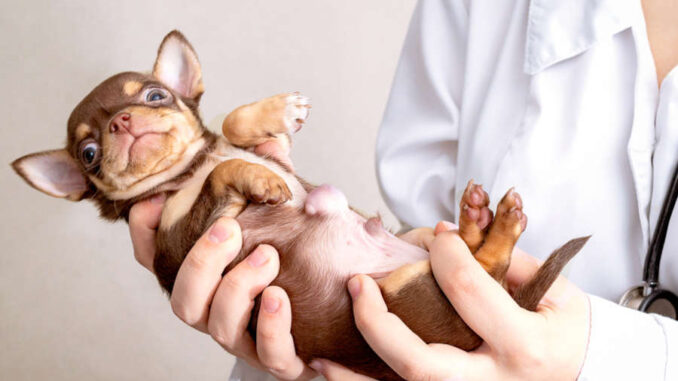
Many of the hernias I see in my vet clinic are found in puppies during their first check up. Indeed, owners are often unaware that there is an issue and most believe an umbilical hernia is just a ‘protruding belly button’.
Hernias are also something I see quite regularly in older dogs, who will have weaker muscles. Perineal hernias, for example, are seen mostly in older intact males who have enlarged prostate glands. Inguinal hernias occur more in un-spayed females who have higher estrogen levels. Knowing the common locations that hernias occur is an important part of my job.
Brief overview of hernias in dogs and what they look like
A hernia occurs when there is a defect in the muscle wall, so things that should be on the inside pop out. Nothing is visible above the skin, but we will notice a bulge or swelling.
The contents of a hernia will vary and depend on where it is located. Some of the things we can find inside hernias include fat, peritoneum and even organs and intestines.
For the dog, they generally do not notice the hernia and it won’t bother them. This is unless it is affecting their ability to pass stool or urine or if the contents of the hernia become ‘strangulated’. Strangulation is a true emergency whereby the blood supply is cut off and this can cause intense pain and other signs such as a fever and vomiting.
What are the different types of hernias in dogs?
Hernia can either be reducible or irreducible. When reducible, we worry a lot less. These hernias can be ‘pushed back in’ to the body with ease. They will come straight back out once the pressure is taken off, but it is reassuring to know that the hernia contents are not stuck outside.
We worry a lot more about irreducible hernias as they are more likely to be associated with a cut off to the blood supply and tissue/organ necrosis going forward.
Let’s take a look at some of the possible hernia locations in our canine patients:
1. Umbilical hernia
This is by far the most common type of hernia I see day to day and they can become apparent on young pups from just a few weeks old. Rather than flat skin over the belly button, there will be a bulge or lump. Most contain just fat.
Very tiny hernias may knit together as the pup grows. However, more often than not, the defect is repaired surgically when the pup is neutered. It is important to neuter these dogs, as the hernia is generally genetic and would be passed on to any offspring.
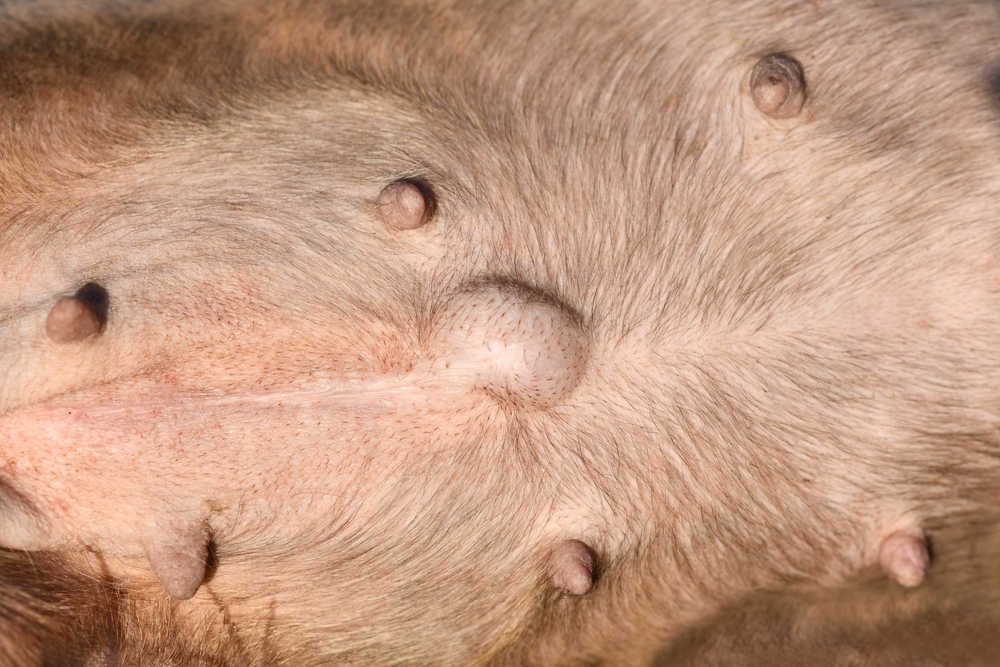
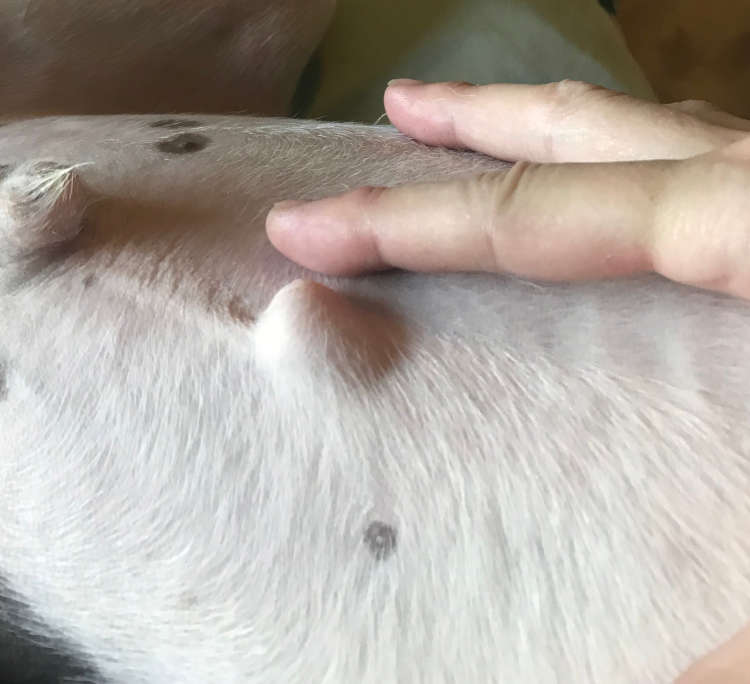
2. Inguinal hernia
An inguinal hernia will appear like a bulge in the groin which can end up being very large indeed. We can see intestines and fat inside these hernias, as well as the bladder. In females, the uterus can even herniate out through the inguinal canal.
They are most commonly seen in elderly females and predisposed breeds include the Basenji, Poodle, Cocker Spaniel and Westie. You can see another picture of inguinal hernia here.
3. Perineal hernia
When a perineal hernia occurs we can see swelling on one or both sides of the anus. Smaller hernias are sometimes confused with anal gland abscesses, but larger ones are more difficult to misdiagnose.
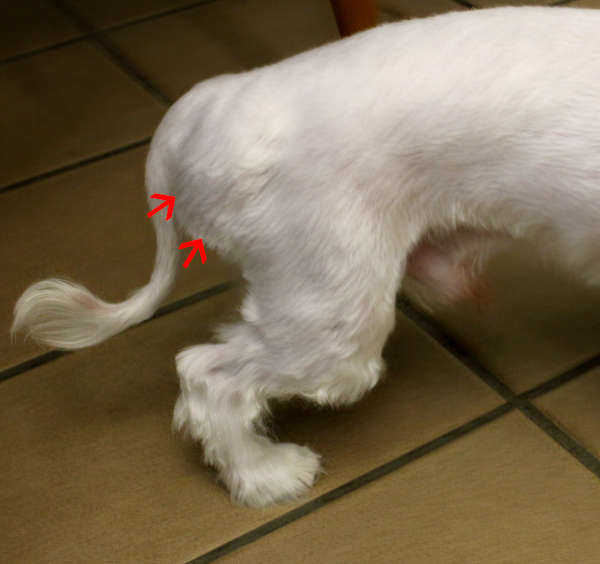
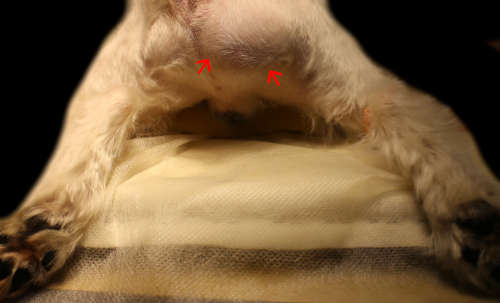
When the muscles weaken (typically with age and due to genetic factors) or tear (due to trauma) things that should be inside the pelvis and abdomen may protrude out into the new space created.
We may notice a dog straining, as if they need to constantly pass poop. In the cases where the bladder has herniated, they may also strain while trying to pass urine and some dogs will become suddenly incontinent.
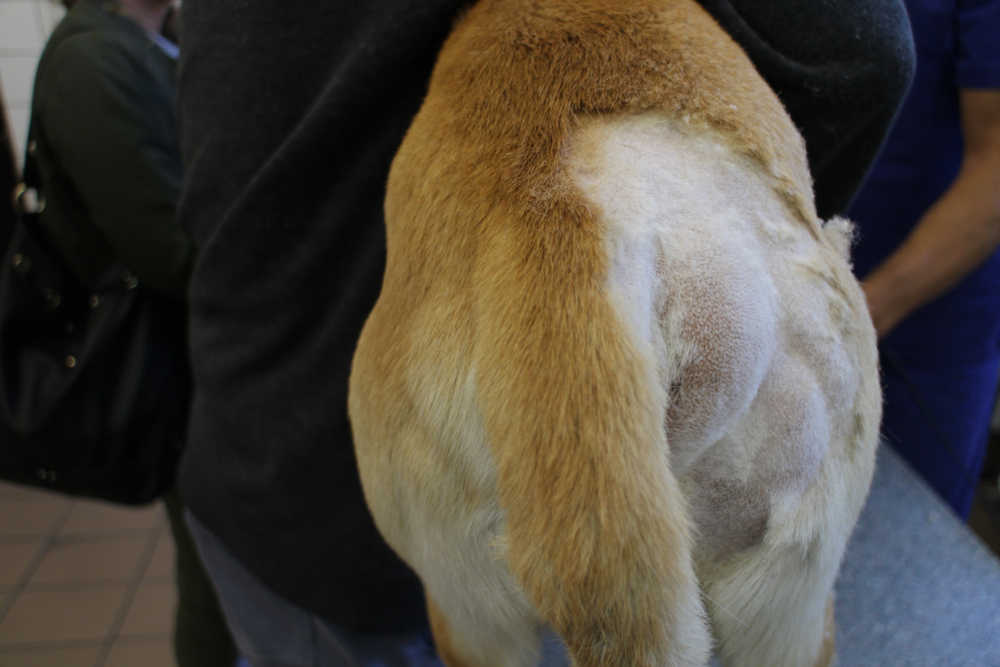
We see this type of hernia more so in older, uncastrated males. They are particularly prevalent in Corgis, Poodles and Dachshunds.
4. Diaphragmatic hernia
Unlike the other three hernias we’ve touched on in this article, a diaphragmatic hernia will not be visible to the outside. Rather, we can only identify them once some imaging of the chest has been done. These hernias can be congenital (meaning the puppy is born with it) or can occur after a severe trauma, such as a car accident or fall from a height.
As the abdominal contents are now found within the chest, there is less space for the lungs to expand and the heart to pump blood. This can cause serious issues with breathing and the circulatory system. Interestingly, those who are born with the defect can sometimes cope quite well for some time and symptoms may be limited to mild lethargy and failure to thrive.
When this type of hernia occurs after a trauma, the dog is usually found to be struggling to breathe and is quite distressed.
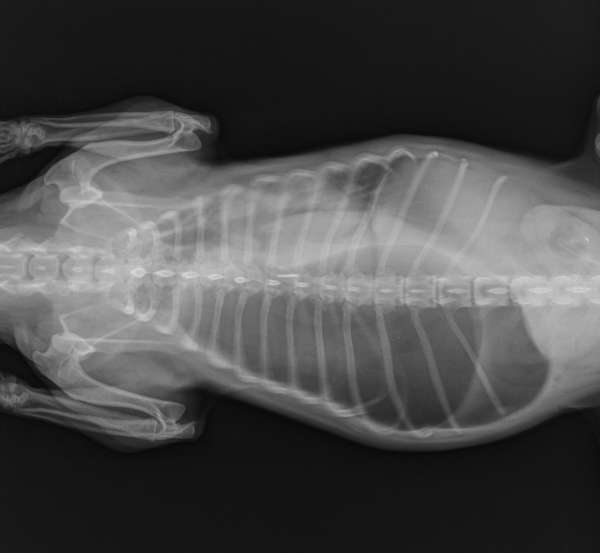
What are the symptoms of hernias in dogs?
Typically, a hernia will present as a bulge where there should not be one. This may be soft or firm and some can be ‘popped’ back in while others cannot. They can be mistaken for tumors or cysts.
Symptoms will depend on the extent of the hernia as well as on its location. For example, a perineal hernia can affect a dog’s ability to pass poop and urine while a diaphragmatic hernia will negatively impact on their breathing and circulation.
How do veterinarians diagnose hernias in dogs?
We usually diagnose a hernia by palpating (feeling) the area and then taking images with an x-ray and/or ultrasound. Imaging is important to determine what the contents of the hernia are, so we can make the best treatment plan for the patient.
With regards diaphragmatic hernias, they aren’t visible on the outside of the body and are only detected on chest x-rays. However, a vet may suspect one if they notice an absence of lung sounds within the chest when listening with their stethoscope. Interestingly, if the stomach or intestines have herniated into the chest, the vet may hear ‘borborygmi’ (or intestinal bubbling and gas) within the chest.
What is the cost of diagnosis?
Diagnosing a straightforward umbilical hernia costs nothing and is done when the vet feels it during a pup’s check up. For other more complex hernias, there will usually be imaging studies. The cost will vary depending on the anesthesia used, the size of the patient and which type of imaging is pursued. As a ball park figure, we could be looking at about $500-1,000.
How are hernias in dogs treated, and what is the prognosis?
Very small hernias that are not worsening, are not impacting the dog and are reducible may be left as they are. This is sometimes the case in pups with umbilical hernias whose owners cannot afford surgery, or in older dogs with perineal or inguinal hernias who would not be good surgical candidates due to other underlying health issues.
For most, surgery is the treatment of choice. Larger hernias can be tricky to surgically correct and it would not be unusual for these surgeries to be carried out by specialists.
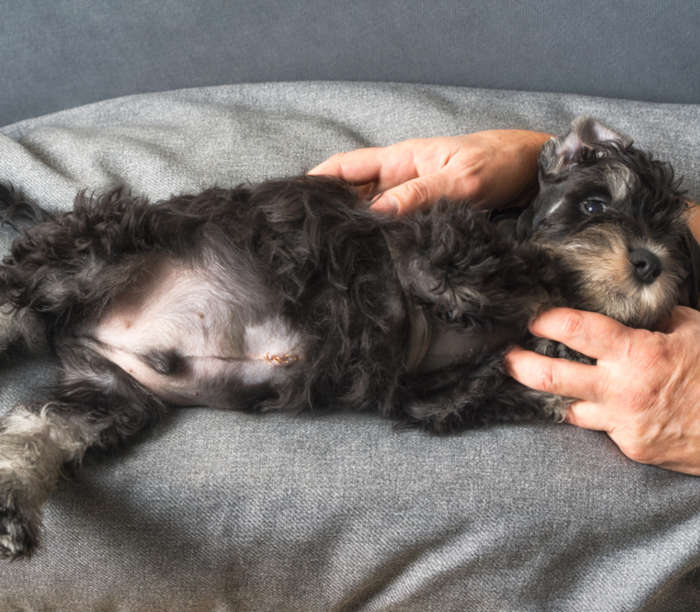
Inguinal hernias tend to carry an excellent prognosis and rarely recur after surgery has been performed.
For perineal hernias, we will usually advocate that the male is castrated at the same time, which can help prevent future herniations and can also reduce prostate size. However, up to about 1/3 of these hernias will recur even after successful surgery.
Specialist surgery is required when it comes to repairing a diaphragmatic hernia. For those who have had a recent trauma, they would be stabilized first, before any surgery is pursued. This can mean providing oxygen, pain relief, IV fluids and treating any serious wounds.
Are there any potential complications I need to be aware of?
The biggest risk when a hernia occurs is that the organ or tissue within the hernia could strangulate, after the blood supply is cut off. If this occurs, the owner may notice the hernia is more firm, dark and warm than usual. Dogs can become quickly unwell and may start to vomit, shiver, refuse their food and have trouble walking.
If a strangulation or obstruction is suspected at any point, this requires immediate vet intervention.
Disclaimer: This website's content is not a substitute for veterinary care. Always consult with your veterinarian for healthcare decisions. Read More.


Be the first to comment